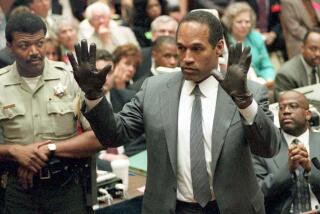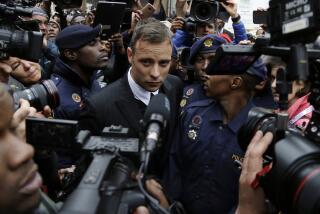On the Ground: From Olympics to prison, the marathon of covering Oscar Pistorius’ fall from grace
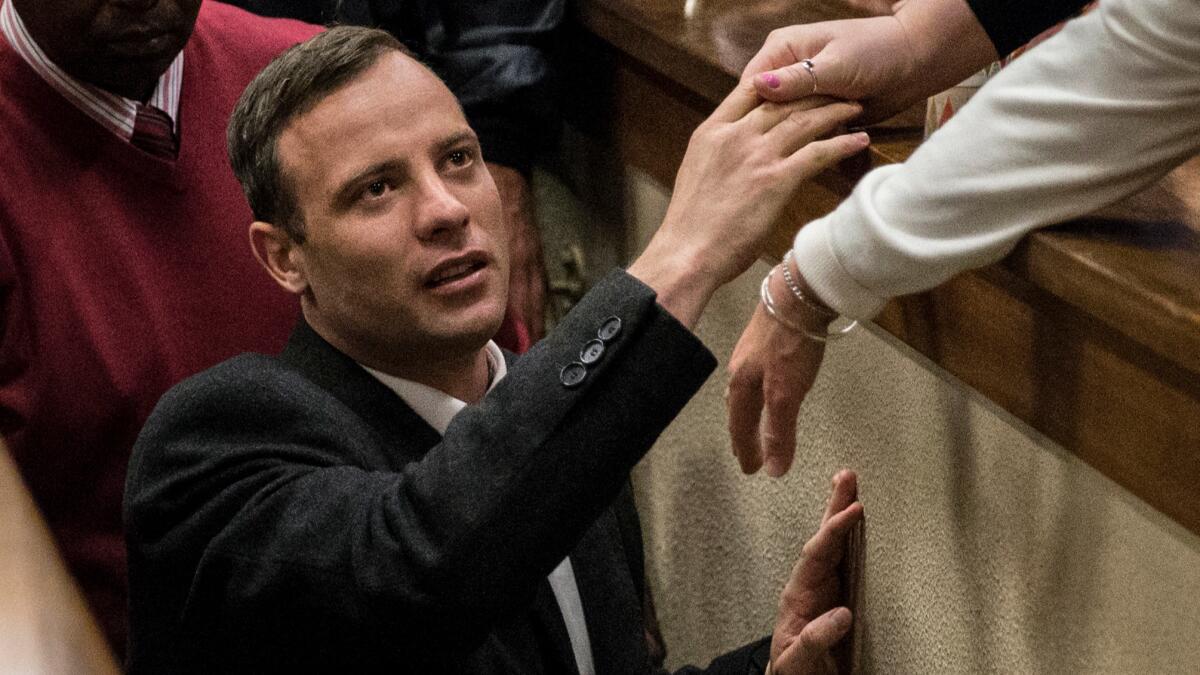
- Share via
Reporting from Pretoria, South Africa — Ten years ago, a young man turned up at a Pretoria athletic field and trotted around the track a few times with casual ease. This must be the man I was waiting for.
His name was Oscar Pistorius, and he was running on carbon fiber blades.
I had an appointment for an interview about his efforts to gain the right to compete in the 2008 Beijing Olympics. When he stopped running, I ambled over, but he barely muttered a greeting. He kept chatting to his friends, avoiding eye contact, a flat start in what seemed an inspiring story.
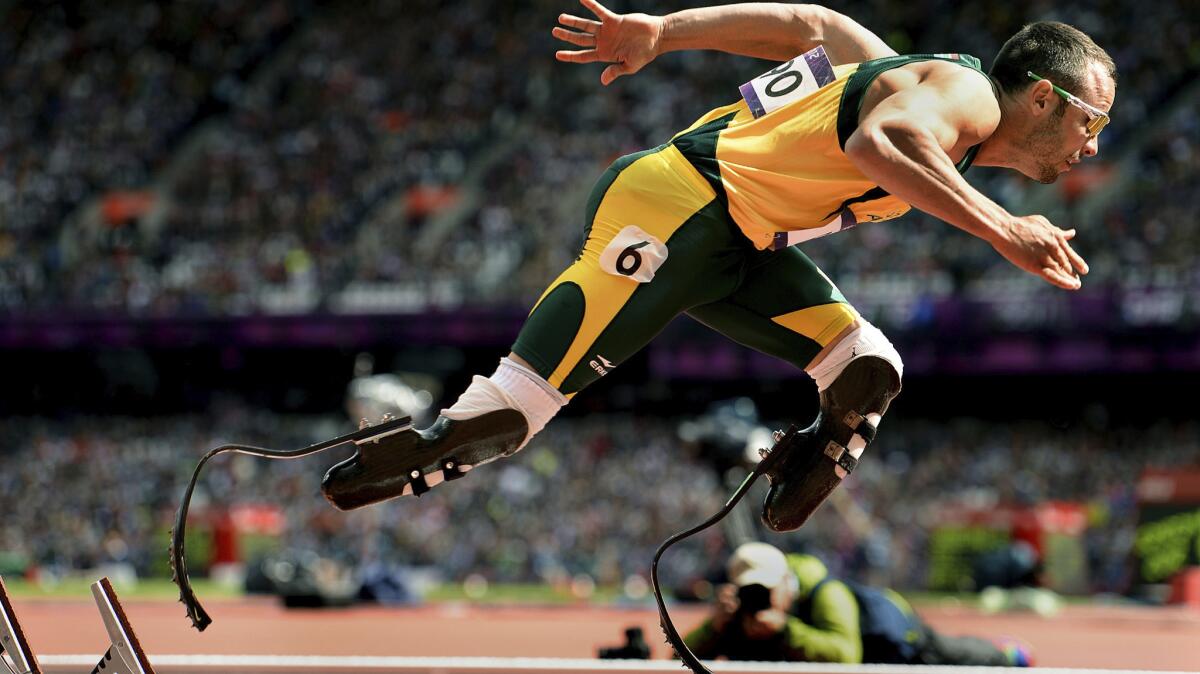
Obviously it wasn’t a good time. I offered to reschedule, but Pistorius never answered a call or text message after that. His coach laughed it off. Oscar was young, he explained. It was all about girls and parties.
That was Pistorius, neither the nicest nor the nastiest celebrity I’ve encountered. The incident would have been a forgotten blip, one of the stories that got away in a lifetime of interviews. But in 2012, Pistorius finally did compete in the London Olympic Games, winning global adulation as a man who overcame extraordinary odds to reach a glorious pinnacle.
But just months later, in February 2013, I found myself packed in a small courtroom with dozens of other journalists for a bail hearing. Pistorius had fatally shot his girlfriend, Reeva Steenkamp, in the early hours of Valentine’s Day.
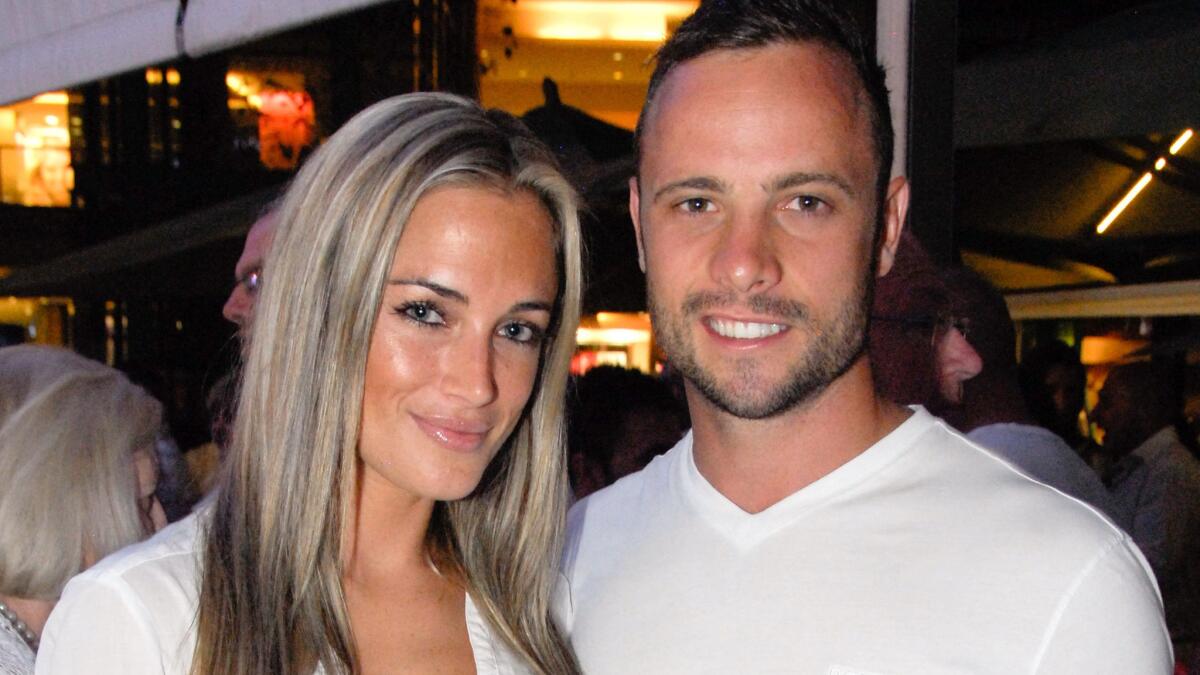
The final turn of his marathon criminal case came Wednesday. On my way to court, I passed the cream-colored brick hulk of Kgosi Mampuru II prison, with its looming watch towers, where Pistorius would be brought hours later, after being sentenced to six years behind bars.
Pistorius, his family and even his attorney weren’t prepared for the international media maelstrom his case created. How could they be? The case lacked the global significance of say, an international criminal court trial of a warlord like Charles Taylor, the Liberian rebel-turned-president-turned-fugitive. Was there anything globally significant about the trial, other than the fact it involved a South African celebrity athlete?
There was not.
Looking back, the global obsession around the Pistorius trial is still difficult to explain. Was it perverse schadenfreude, discovering our heroes are flawed like the rest of us?
The athlete’s 2014 trial punctured the gilded image of Pistorius as the nice guy who refused to be defined by a disability. He came to be seen alternately as a tragic victim of horrible luck, or an angry, violent, gun-obsessed killer, depending on your point of view. And everybody seemed to have one. Each side had its army of Twitter trolls.
With journalists from around the world covering the case, I crammed onto a polished wooden bench with a tangle of electrical wires at my feet snaking from extension cords connecting dozens of computers and cellphones. There was always a morning scramble for a seat and a place to plug in, and then a flurry of tweets on the arrivals of the main players. Pistorius’ entrance usually was marked by a sudden hush but for the chatter of clicking cameras. His appearance would be minutely scrutinized and broadcast in dozens of tweets: Was he pale or “puffy-eyed”? Was he emotional? Did he look grim or upbeat?
We were squashed behind the two families: the Pistorius family and supporters at one end on their bench, behind the athlete and his lawyer, and the Steenkamps at the other end, behind the prosecutor.
A police officer would bark out orders for silence in Afrikaans and English, and we would balance laptops and phones, shuffle to our feet and bow to the judge.
The combination of terrible acoustics and lack of amplification made some witnesses and soft-spoken Judge Thokozile Masipa hard to hear.
It was difficult to remain unaffected by the raw emotion of the trial, when Pistorius howled with visceral grief over Steenkamp’s death, a wild, almost animal sound that rose in the courtroom. He vomited into a bucket at the graphic forensic description of the damage his bullets did. And in the final days, Steenkamp’s heartbroken father, Barry, took the stand, telling the court how he pricked himself with a needle to try to understand the pain of a dying daughter. He found it in his heart to forgive Pistorius.
There were dramatic stumbles: Police blunders over the crime scene (an officer stole one of Pistorius’ watches, the court heard) and Masipa’s obvious flaw in reasoning in convicting Pistorius of culpable homicide, or negligent killing, a ruling that was unanimously overturned in the Supreme Court of Appeal last December. Instead, the athlete was convicted of murder.
The clues to Pistorius’ fallibility had been there for years. He had to apologize in 2007 for calling the International Assn. of Athletics Federations “amateurs” and “unprofessional” for refusing to let him compete against able-bodies athletes, based on their ruling that his carbon fiber blades gave him an advantage. (The IAAF ruling was overturned at the Court of Arbitration for Sport in 2008, too late for Pistorius to compete in the Beijing Olympic Games that year, but he went on to compete at the Olympics and Paralympics in London in 2012.)
After losing his 200-meter race at the 2012 Paralympics, he angrily accused the winner, Alan Oliveira, of using carbon fiber blades that were too long and thus unfair.
His trial captured competing versions of Pistorius that ultimately amounted to one flawed man. The prosecution presented evidence of how he fired a gun in a restaurant and lied about it, refused to respect police who pulled him over for speeding and lost his temper with a prison nurse in an argument over medications. Prosecutor Gerrie Nel aired a video of the athlete firing a powerful bullet at a watermelon, laughing uproariously and calling it a “zombie-stopper.” The defense highlighted his frailty, vulnerability and charitable works, and twice had the athlete remove his prosthetics to show Masipa his stumps, or to walk without his artificial legs.
On Wednesday, the court again was crowded. The conversation in the public gallery before the trial started was loud and excitable. A hush fell as a police officer said, “Rise in court,” and it began.
Masipa read her findings softly and steadily, telling us that Pistorius had ruined the Steenkamps’ lives and his own. Which Pistorius would she choose? The arrogant gun-obsessed celebrity with a love of fast cars and blonds? Or the vulnerable, paranoid, broken man, wracked with remorse, anxiety and depression?
In the end, Masipa went with the vulnerable Oscar. She said he was “a different person” when moving on his stumps, as he was when he fired the fatal shots. She declared it was not in the interests of justice for Pistorius to serve a long prison term.
A few feet away from me, Pistorius hugged his sister Aimee with his eyes closed, clinging to the moment, before police led him down to the cells. His sister fled the court weeping.
On the other side of the court, the Steenkamp family looked stony and shocked.
Unless the state appeals, Wednesday will be the last day of the marathon case the world was always so hungry for. I won’t be sorry to see its end.
More to Read
Sign up for Essential California
The most important California stories and recommendations in your inbox every morning.
You may occasionally receive promotional content from the Los Angeles Times.

